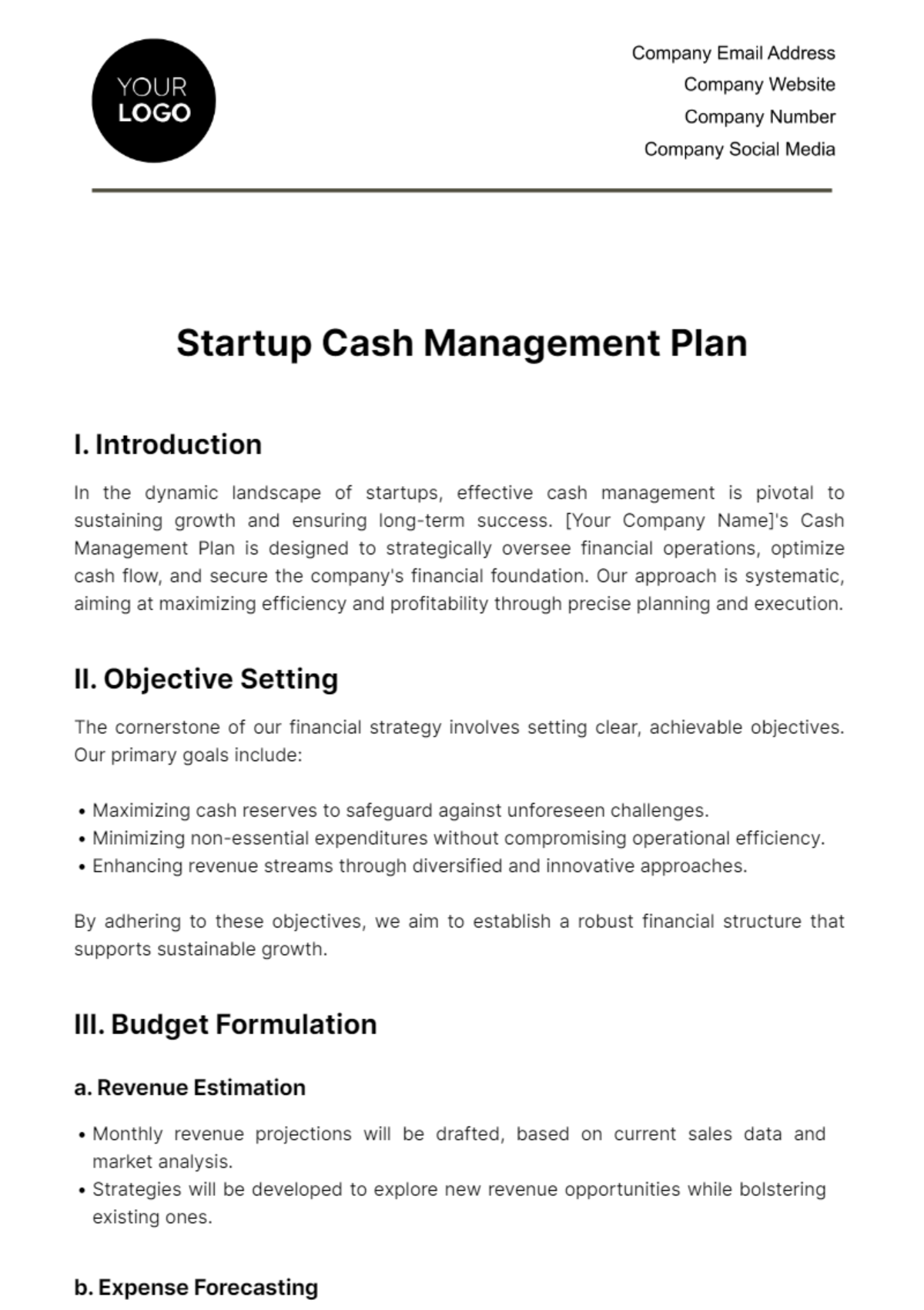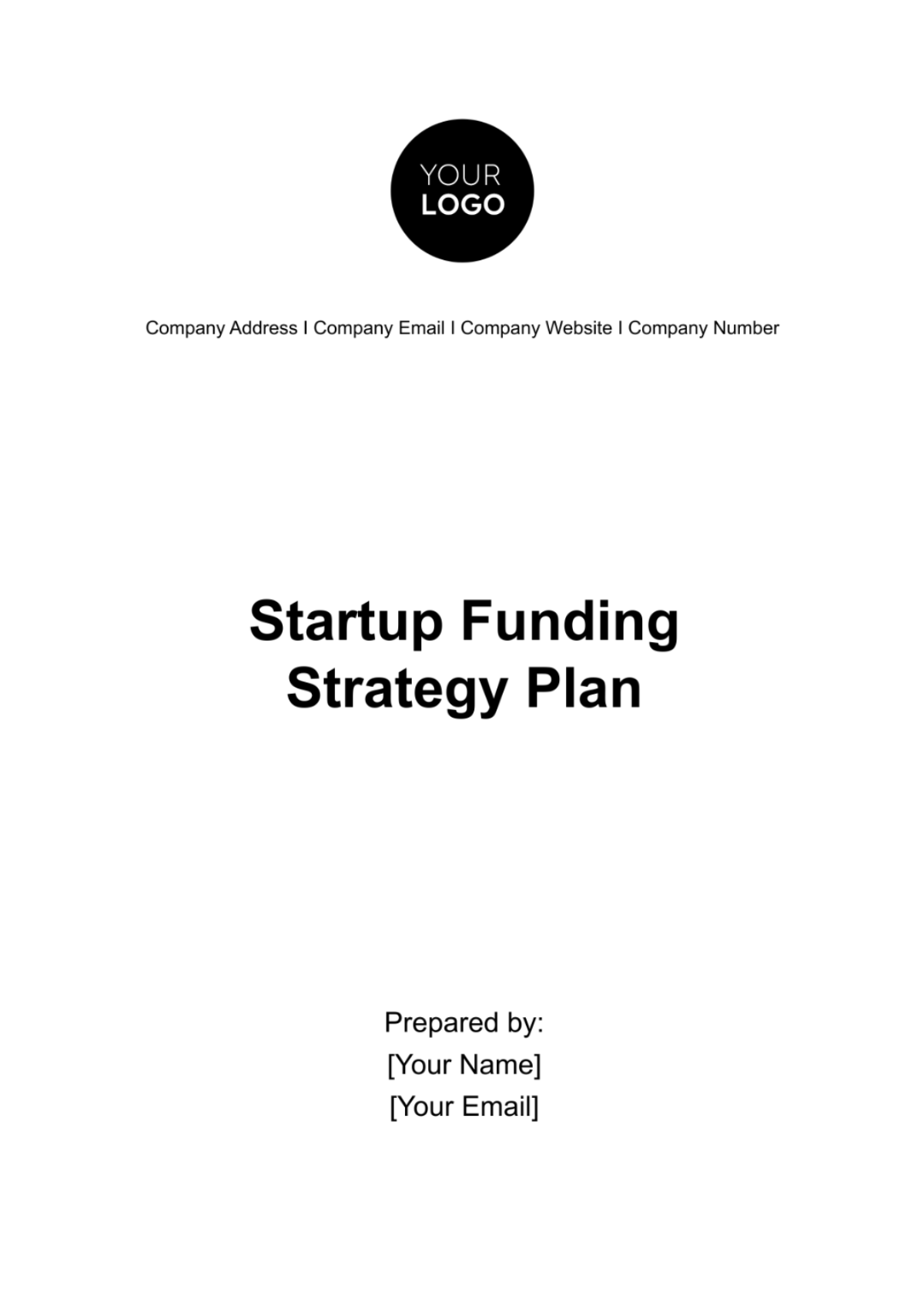Startup Capital Structure & Equity Distribution Plan
Introduction
In the journey of building a successful startup, establishing a clear and strategic Capital Structure and Equity Distribution Plan is paramount. This plan serves as the foundation for our financial architecture, delineating how equity is allocated among founders, employees, investors, and advisors. It reflects our commitment to transparency, fairness, and shared success, aligning with our mission to create value for all stakeholders while navigating the path to growth and profitability. By laying out a structured approach to equity distribution, we aim to foster a culture of ownership and incentive alignment, ensuring that all contributors are vested in the company's success.
Capital Structure Overview
Our startup's capital structure is designed to be flexible, supporting our growth objectives while accommodating the interests of diverse stakeholders. It comprises various securities that offer different rights and privileges, tailored to meet the needs of our dynamic and evolving business environment.
Types of Securities Issued:
Common Stock: Equity shares offering voting rights and a proportional share in the company's success.
Preferred Stock: Shares that provide preferential treatment in dividends and liquidation events, often issued to investors.
Options: Rights granted to employees and advisors to purchase stock at a future date at a predetermined price, fostering long-term commitment.
Warrants: Similar to options, but typically issued to investors, allowing them to purchase stock at a specified price before expiry.
Equity Allocation
Equity allocation is a strategic process, ensuring that each stakeholder group is incentivized appropriately for their contribution to our startup's success. Our plan is designed with scalability and adaptability in mind, recognizing the changing dynamics as we grow.
Equity Allocation among Different Stakeholders
Stakeholder | Criteria | Initial Allocation Percentages |
Founders | Contribution, role, and risk taken | 60% (divided equally among founders) |
Key Employees | Impact on startup growth, expertise, tenure | 20% (from an employee equity pool) |
Advisors | Strategic value, industry connections | 5% (vested over 2 years) |
Investors | Capital provided, valuation agreement | 15% (across financing rounds) |
The distribution reflects our belief in rewarding early risk, contribution, and the strategic importance of external capital and advice.
Equity Dilution and Anti-Dilution Protections
Equity dilution occurs as we issue more shares, for instance, during fundraising or through the exercise of options. While dilution is a natural part of startup growth, we aim to manage it carefully to maintain fairness. Anti-dilution protections are in place for preferred stockholders, typically through weighted average or full ratchet provisions, ensuring their investment retains value even as new shares are issued. These mechanisms are crucial for balancing the interests of early and later-stage investors, ensuring that all parties are treated equitably as our company scales.
Founder Equity
The allocation of founder equity is a critical component of our startup's equity distribution plan, reflecting the founders' commitment, vision, and ongoing contributions to the company. This equity is distributed to recognize the significant risks founders take and the instrumental role they play in the startup's inception and growth. A thoughtful approach to founder equity, including vesting schedules and rights, ensures that founders remain motivated and aligned with the company's long-term success. Here are some considerations:
Vesting Schedule: Typically, founder shares are subject to a four-year vesting period with a one-year cliff. This means that founders earn their equity over time, encouraging long-term commitment.
Cliff Period: Founders must remain with the company for at least one year to earn any equity, protecting the startup if a founder departs early.
Acceleration Provisions: In certain events, such as a sale of the company, founders may be entitled to accelerated vesting, ensuring they are rewarded for their early contributions.
Buyback Options: Conditions under which the startup can buy back equity from departing founders, maintaining control and redistributing equity as needed.
Employee Equity Pool
The employee equity pool is designed to attract, retain, and motivate key talent, recognizing their role in our startup's growth and success. The size and structure of this pool reflect our strategic priorities and the competitive landscape for talent in our industry.
Size and Structure of Equity Pool
Our startup has allocated 20% of its total equity to the employee equity pool, ensuring a significant share of ownership is reserved for future hires. This pool includes options and restricted stock units (RSUs), providing flexibility in tailoring compensation packages to individual roles and contributions.
Guidelines for Granting Equity
Role and Impact: Equity grants are based on the employee's role, seniority, and potential impact on the company's growth.
Vesting Schedule: Standard vesting over four years with a one-year cliff to encourage long-term commitment.
Performance Milestones: Additional grants may be considered for exceptional contributions, aligning incentives with company milestones and success.
Market Standards: Grants are competitive with market standards, ensuring we attract and retain top talent.
Investor Equity
Investor equity is structured to acknowledge the financial risk taken by external investors, providing them with a stake in the company's future returns. The terms and conditions associated with investor equity are carefully negotiated to balance investor protection with the founders' vision and control. Here are the terms and conditions:
Preferred Stock: Investors typically receive preferred stock, offering advantages like priority in dividends and liquidation preference over common stock.
Voting Rights: Although preferred stock may have limited voting rights, specific protective provisions ensure investors have a say in major decisions.
Conversion Rights: Investors can convert their preferred stock into common stock, usually on a one-to-one basis, particularly advantageous in the event of an IPO.
Anti-Dilution Protections: To safeguard their investment, investors may have anti-dilution rights, adjusting their ownership percentage if future shares are issued at a lower valuation.
Dividend Preferences: Preferred investors may receive dividends before common stockholders, at a predetermined rate.
Advisory and Board Member Equity
Equity compensation for advisors and board members is a strategic tool to align their interests with the long-term success of our startup. Recognizing the value of their expertise, network, and strategic guidance, we offer equity as part of their compensation package. This approach incentivizes them to contribute meaningfully to our growth and success. The equity allocation to advisors and board members is carefully calibrated to reflect their impact, commitment, and the standard practices within our industry. By integrating these stakeholders into our equity structure, we foster a culture of shared ownership and collaboration, ensuring that our advisors and board members are directly invested in the company's achievements. Here are some considerations:
Vesting Schedule: Equity vests over a period, typically two to four years, ensuring ongoing engagement and contribution.
Cliff Period: A one-year cliff may apply, after which the equity begins to vest, encouraging a minimum commitment period.
Equity Cap: A cap on the total equity allocated to advisors and board members ensures that founder and employee ownership remains prioritized.
Role-Specific Allocations: Equity grants are tailored to the individual's role, expertise, and the value they bring to the startup.
Equity Distribution Mechanisms
Our startup employs various mechanisms for distributing equity, each tailored to suit the needs of different stakeholders while complying with legal and tax implications. These mechanisms are designed to ensure fairness, transparency, and alignment with our strategic goals.
Direct Issuance of Shares: Offering shares directly to founders, employees, advisors, or investors as part of their equity compensation or investment.
Stock Options: Granting the option to purchase shares at a fixed price in the future, commonly used for employees as part of an incentive package.
Restricted Stock Units (RSUs): Awarding shares that are subject to vesting, providing employees with the incentive to remain with the company and contribute to its success.
Convertible Notes: A form of short-term debt that converts into equity, typically used in early-stage financing rounds.
SAFEs (Simple Agreement for Future Equity): An agreement that allows investors to convert their investment into equity at a later date, typically used in seed financing.
Governance and Decision-Making
Our startup's approach to governance and decision-making is structured to promote transparency, accountability, and strategic alignment across all levels of the organization. By establishing clear governance practices, we ensure that all stakeholders have a voice in key decisions, while also facilitating effective oversight and management of the company's operations. This framework supports our mission to build a sustainable, growth-oriented business that remains responsive to the needs of our customers, employees, and investors.
Voting Rights: Voting rights are a fundamental aspect of our governance structure, enabling shareholders to influence the company's direction. Common shareholders typically have the right to vote on major corporate decisions, including the election of board members and significant corporate actions like mergers or acquisitions. Preferred shareholders may have limited or specified voting rights, often related to protective provisions that safeguard their investment.
Board Composition: Our board of directors is composed of a balanced mix of founders, investors, and independent members who bring diverse perspectives and expertise to the company's strategic decisions. The composition of the board is designed to ensure that it represents the interests of all stakeholders, guiding the company towards achieving its strategic objectives while managing risks.
Shareholder Meetings: We hold annual shareholder meetings to report on the company's performance, address shareholder queries, and conduct votes on key issues. These meetings offer a platform for transparency and engagement, allowing shareholders to directly interact with the company's leadership and express their views on its governance and strategy.
Legal and Regulatory Considerations
Navigating the legal and regulatory landscape is crucial for maintaining our startup's compliance and protecting the interests of all stakeholders. From incorporation to equity distribution and operational compliance, understanding and adhering to the applicable laws and regulations is essential for our success and longevity.
Securities Laws: Compliance with federal and state securities laws is critical, especially during fundraising activities. This includes adhering to regulations regarding the offer and sale of securities, investor accreditation, and disclosure requirements.
Employment Laws: Understanding and complying with employment laws, including wage and hour laws, anti-discrimination statutes, and benefits regulations, is essential for managing our workforce ethically and legally.
Intellectual Property Laws: Protecting our intellectual property through patents, trademarks, and copyrights is vital for securing our competitive advantage and ensuring that our innovations and brand identity are legally safeguarded.
Privacy and Data Protection Laws: Adherence to privacy and data protection laws, such as the General Data Protection Regulation (GDPR) for European customers and the California Consumer Privacy Act (CCPA), is crucial for managing customer data responsibly and maintaining trust.
Corporate Governance Laws: Compliance with corporate governance laws and regulations, including those related to board composition, shareholder rights, and financial disclosures, ensures that our startup operates with integrity and transparency.
Future Fundraising and Exit Strategies
As our startup evolves, future fundraising rounds and eventual exit strategies are pivotal components of our financial planning and growth trajectory. These initiatives are carefully designed to align with our long-term goals, ensuring we can capitalize on opportunities to scale and maximize value for all stakeholders. Our approach to fundraising is strategic and data-driven, aiming to partner with investors who share our vision and can contribute more than just capital. As we consider future exits, our plan remains flexible to adapt to the market environment and the interests of our shareholders.
Acquisition: Targeting strategic buyers who can offer synergies and enhanced market positioning, providing a lucrative exit for investors and founders.
Merger: Combining forces with a complementary business to scale more effectively and unlock new market opportunities.
Initial Public Offering (IPO): Taking the company public to access broader capital markets, offering a significant return on investment for early stakeholders.
Secondary Market Sale: Facilitating the sale of shares to private investors or other companies, providing liquidity to early investors and employees.
Management Buyout (MBO): Allowing the management team or employees to purchase the business, ensuring continuity and commitment to the company's vision.
Review and Adjustment Process
Our Capital Structure and Equity Distribution Plan is not set in stone; it is a dynamic framework that will evolve alongside our startup. Regular reviews and adjustments are integral to this process, ensuring our strategies remain relevant and effective in the face of growth challenges, market changes, and evolving stakeholder needs. This review process involves analyzing our capital structure, assessing the effectiveness of equity allocations, and making necessary adjustments to support our strategic objectives. Input from key stakeholders, along with insights from financial and legal advisors, plays a crucial role in this iterative process, ensuring our plans are both ambitious and grounded in reality.
Conclusion
Establishing a thoughtful and strategic Capital Structure and Equity Distribution Plan is foundational to our startup's success. It not only aligns with our immediate financial needs but also sets the stage for sustainable growth and value creation. By carefully balancing the interests of founders, employees, advisors, and investors, we've laid a solid foundation for collaboration, innovation, and shared success. As we move forward, our commitment to transparency, fairness, and strategic agility will guide our decisions, ensuring we remain adaptable and focused on achieving our long-term vision. Our plan is not merely about distribution of equity; it's about building a community of stakeholders who are deeply invested in bringing our shared vision to life.


























